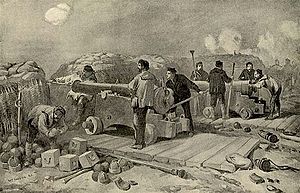Siege of Sevastopol
| date |
October 17, 1854 - September 9, 1855 |
|---|---|
| place | Sevastopol |
| output | Allied victory |
| Peace treaty | Third Paris Peace |
| Parties to the conflict | |
|---|---|
| Commander | |
|
|
|
Olteniţa - Akhaltsikhe - Başgedikler - Sinope - Cetate - Silistra - Nigojeti - Tscholok - Odessa - Kurekdere - Petropavlovsk-Kamchatsky - Alma - Sevastopol - Bomarsund - Balaklava - Inkerman - Yevpatoria - Taganrog - Çorğun - Kars - Tschernaja - Malakoff - Kinburn - Third Paris peace
The siege of Sevastopol took place during the Crimean War from 1854 to 1855 between Russia on the one hand and the Ottoman Empire , France , Great Britain and, from 1855 on, the Kingdom of Sardinia (the politically formative forerunner state of later Italy ) on the other. The storming of the city by the Allies finally ended the Crimean War.
course
On September 14, 1854, British and French troops landed in the Bay of Kalamita , north of Sevastopol near Saky , in the Crimea . After they were victorious in the Battle of the Alma , they began encircling Sevastopol on October 9th. The Russian Black Sea Fleet sank in the city's port, preventing an attack by the Allies with the support of their fleet. The fortifications were mainly oriented to the north, on the sea side. Because of this, the Allies decided to besiege Sevastopol from the south, never completely enclosing the city. The Baltic German engineer officer and later General Eduard Totleben therefore had a system of field entrenchments, battery positions and trenches built at short notice, which enabled the fortress to be defended for almost a year.
The siege was marked by catastrophic medical conditions among the Allies. In addition to numerous soldiers, the French commander-in-chief Saint-Arnaud , the British commander Raglan and the commander of the French fleet Armand Joseph Bruat died of cholera . The Russians tried to end the siege on October 25, 1854 at the Battle of Balaklava and on November 5, 1854 at the Battle of Inkerman , both unsuccessfully.
From October 1854, mutual bombardments took place at the positions, which required unprecedented amounts of grenades. On April 9, 1855, a particularly intensive bombardment of the city began. The British chief engineer John Fox Burgoyne saw the center of the Russian position in Fort Malakow and concentrated the fire of the Allies there. In May 1855 there were 35,000 British and 75,000 French (including the reserve army in Istanbul: 30,000), as well as 60,000 Ottomans in the Crimea. At the end of May, 14,000 Italians also arrived. The Ottoman commander in chief was Serdar-i Ekrem Omar Pascha . His staff included Abdullah Pascha Marzioğlu (initially Bey ), Salih Paşa, Iskender Bey and Halil Paşa.
The Allied fleets ruled the Black Sea , sank transport ships and shot at both military and civilian objects on the coast. On August 16, the Russians tried again in vain to lift the siege through the battle of the Chernaya .
The struggle for the Sevastopol fortress reached its climax after almost a year of siege and ended at the same time with the storming of the Malakov fort . After three days of bombardment of the city by 775 British and French artillery pieces, three French and two British divisions attacked the fortress in several places. After the French conquest of Malakov under the command of Generals Patrice de Mac-Mahon and Pierre Bosquet on September 8, 1855, the Russian defenders had to evacuate the entire city of Sevastopol. Since the fortress allowed control of the Black Sea port of Sevastopol, the Russian troops blew up the facilities and withdrew.
On March 30, 1856, Russia finally concluded the Peace of Paris with its war opponents .
Trivia
As the last surviving participant of the siege, the tortoise Timothy, known in Great Britain, died on April 4, 2004 at the age of around 160 years. She was the mascot on the HMS Queen , which bombed Sevastopol with artillery during the siege .
After the battle, u. a. named the Boulevard de Sébastopol in Paris.
literature
- German Werth: The Crimean War. The world power Russia was born. (= Ullstein-Taschenbuch 34949). Frankfurt am Main / Berlin 1992, ISBN 3-548-34949-8 (license from Straube, Erlangen / Bonn / Vienna 1989, ISBN 3-927491-08-X ).
- Alexander Rodger: Battle honors of the British Empire and Commonwealth Land Forces, 1662-1991. Ramsbury, Crowood 2003, ISBN 1-86126-637-5 (English).
- AW Kinglake: The Invasion of the Crimea. nine volumes. London 1863-87. (Reprinted from Naval & Military Press, 2003, ISBN 1-84342-497-5 ).
- Andrew D. Lambert: The Crimean War . Manchester University Press, London 1990, ISBN 0-7190-3564-3 .
- Inge and Dieter Wernet: The Siege of Sevastopol 1854–1855. Helios-Verlag, Aachen 2017, ISBN 978-3-86933-181-2 .
- Gustav Weigelt , The Siege of Sebastopol 1854-1856. With special consideration of the artillery activity in the same , 1861, digitized

